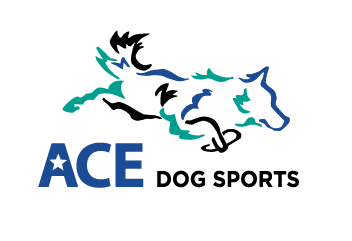Discover the Sport
What is Agility?
The technical definition:
Agility is a sport that consists of an obstacle course that handlers maneuver their dogs through. In competitions the dogs and their handler must perform the course accurately in a pre-determined amount of time to pass the judge’s test. The course is always different. The dog with fastest time of all the accurate dogs is the winner.
The ACE definition:
Agility is a highly addictive and super fun sport that challenges you and your dog’s brain and body. It is intense teamwork. It is primo bond building. It is the ultimate high for dog lovers.
Who does agility?
Your everyday dog lovers and your hard-core athletes. Our students come in all shapes and sizes and so do their dogs.
FAQs
What is the minimum age requirement for dogs to do agility?
Training should start the day you get your dog or puppy. My online ‘BAM! Pre-Agility’ course is a good place to start with any dog over 4 months old. Dogs should not do full-size obstacles until they are 1 to 2 years old depending upon the breed.
Can older dogs do agility?
That depends on the dog. Training can be modified so that older dogs can still play. In general, smaller breeds can participate longer than larger breeds. Breeds not built for physical activity will have to retire sooner than the more athletic breeds. If your dog is older than 9 years old consult your veterinarian.
Do my dog and I have to be physically fit to do agility?
Agility students come in all shapes and sizes and so do their dogs! The sport has several jump heights to accommodate the smallest and largest of breeds. Dogs that are not in good physical condition can work at a lower jump height until they get in shape! Handlers who are not in good physical shape will find many more just like them excelling at agility! And age is not a factor – we have students ranging in age from 9 to 80!
My dog is aggressive or reactive around dogs. Can I do agility?
You do not have to join an in-person class to pursue agility. It is not a good idea to put some dogs with low coping skills into an agility class. The environment is very stimulating and it can actually bring out the worst in dogs that are reactive. Better to get control over the dog before pursuing an in-person agility class; seek professional help first. In the meantime take an online class to see if you and your dog are suited for agility.
How much control over my dog do I need to start agility?
Sandy recommends perfecting the skills in the online ‘BAM! Pre-Agility’ course before enrolling in an in-person class. If you enroll in a class and do not have control of your dog no one can predict the outcome. Students who roll up their sleeves and work hard to achieve off-leash control will be able to progress much faster. How much time you have to train, and how committed you are to getting control over your dog, are the critical factors. Wanting to do agility can be a wonderful motivator to expand your training skills.
Can a person really learn how to train a dog online?
Online training gives handlers a chance to teach their dogs in an environment where they are both comfortable and at their own pace. This can make for a much more enjoyable and successful experience. Many handlers find that trying to absorb the instruction while managing an untrained dog can be frustrating. Once skills are established the team can then train in places where there are other dogs and people.
Can I learn agility with minimal or no real agility equipment?
YES. When Sandy taught agility in San Francisco none of her students had agility equipment, they mostly lived in apartments! Sandy has developed innovative training that solves this very real dilemma. The ‘BAM! Pre-Agility’ course teaches basic and advanced handling using a few household items that easily fit in any small car.
My dog knows all the obstacles. Am I ready to compete?
That depends. The obstacles do have to be executed according to the rules so they must have been trained correctly. The obstacles are ‘generally’ the easier part of the agility training. The cueing of the direction changes (turn cues) needed to navigate courses off-leash usually takes working with an experienced instructor in-person or online. That instructor can then help you decide when you are ready to compete. Don’t have a trainer? Travel to any agility competition and watch, that will give you a good idea of where you and your dog are on your training journey.
What is the difference between a beginner and an experienced handler?
Agility enthusiasts are usually considered beginners until they achieve the handling ability equal to someone that is competing at the mid-level. We are beginners for a long time. Experienced handlers can execute a full-sized course that might be used in higher levels of competition.
Resources
Videos
Included here are a variety of video clips that include dogs doing agility and instructional tips.
Useful Links
We have provided these links to take you beyond ACE into the wonderful world of Dog Agility.



